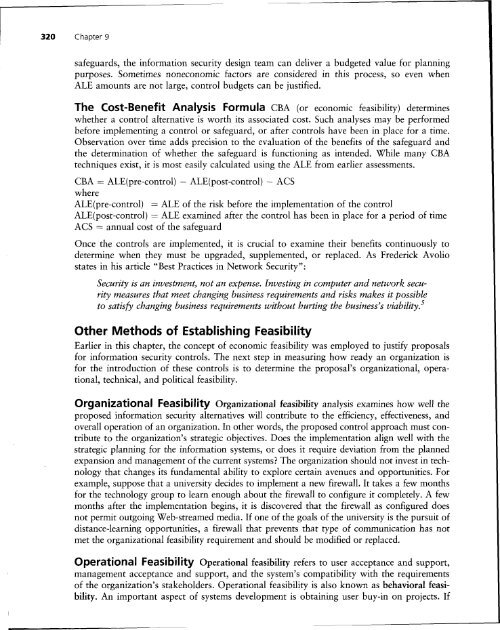Weakness is a better teacher than strength ... - PDF Archive
Weakness is a better teacher than strength ... - PDF Archive
Weakness is a better teacher than strength ... - PDF Archive
Create successful ePaper yourself
Turn your PDF publications into a flip-book with our unique Google optimized e-Paper software.
320 Chapter 9<br />
safeguards, the information security design team can deliver a budgeted value for planning<br />
purposes. Sometimes noneconomic factors are considered in th<strong>is</strong> process, so even when<br />
ALE amounts are not large, control budgets can be justified.<br />
The Cost-Benefit Analys<strong>is</strong> Formula CBA (or economic feasibility) determines<br />
whether a control alternative <strong>is</strong> worth its associated cost. Such analyses may be performed<br />
before implementing a control or safeguard, or after controls have been in place for a time.<br />
Observation over time adds prec<strong>is</strong>ion to the evaluation of the benefits of the safeguard and<br />
the determination of whether the safeguard <strong>is</strong> functioning as intended. While many CBA<br />
techniques ex<strong>is</strong>t, it <strong>is</strong> most easily calculated using the ALE from earlier assessments.<br />
CBA = ALE(pre-control) - ALE(post-control) - ACS<br />
where<br />
ALE(pre-control) = ALE of the r<strong>is</strong>k before the implementation of the control<br />
ALE(post-control) = ALE examined after the control has been in place for a period of time<br />
ACS = annual cost of the safeguard<br />
Once the controls are implem~nted, it <strong>is</strong> crucial to examine their benefits continuously to<br />
determine when they must be upgraded, supplemented, or replaced. As Frederick Avolio<br />
states in h<strong>is</strong> article "Best Practices in Network Security":<br />
Security <strong>is</strong> an investment, not an expense. Investing in computer and network security<br />
measures that meet changing business requirements and r<strong>is</strong>ks makes it possible<br />
to sat<strong>is</strong>fy changing business requirements without hurting the business's viability. 5<br />
Other Methods of Establ<strong>is</strong>hing Feasibility<br />
Earlier in th<strong>is</strong> chapter, the concept of economic feasibility was employed to justify proposals<br />
for information security controls. The next step in measuring how ready an organization <strong>is</strong><br />
for the introduction of these controls <strong>is</strong> to determine the proposal's organizational, operational,<br />
technical, and political feasibility.<br />
Organizational Feasibility Organizational feasibility analys<strong>is</strong> examines how well the<br />
proposed information security alternatives will contribute to the efficiency, effectiveness, and<br />
overall operation of an organization. In other words, the proposed control approach must contribute<br />
to the organization's strategic objectives. Does the implementation align well with the<br />
strategic planning for the information systems, or does it require deviation from the planned<br />
expansion and management of the current systems? The organization should not invest in technology<br />
that changes its fundamental ability to explore certain avenues and opportunities. For<br />
example, suppose that a university decides to implement a new firewall. It takes a few months<br />
for the technology group to learn enough about the firewall to configure it completely. A few<br />
months after the implementation begins, it <strong>is</strong> d<strong>is</strong>covered that the firewall as configured does<br />
not permit outgoing Web-streamed media. If one of the goals of the university <strong>is</strong> the pursuit of<br />
d<strong>is</strong>tance-learning opportunities, a firewall that prevents that type of communication has not<br />
met the organizational feasibility requirement and should be modified or replaced.<br />
Operational Feasibility Operational feasibility refers to user acceptance and support,<br />
management acceptance and support, and the system's compatibility with the requirements<br />
of the organization's stakeholders. Operational feasibility <strong>is</strong> also known as behavioral feasibility.<br />
An important aspect of systems development <strong>is</strong> obtaining user buy-in on projects. If

















